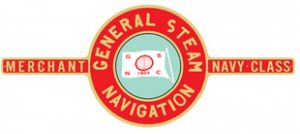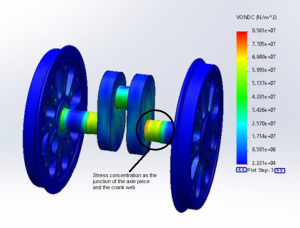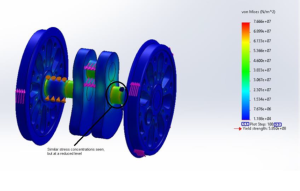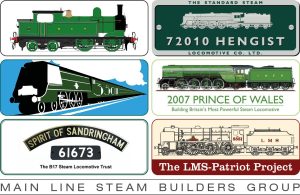
Spring Engineering Update
Boiler

Work continues on the boiler with the last of the remaining boiler tube stubs being removed last month. A big thank you goes out to the sterling work by our volunteers (including Paul G, David O, Geoff A & Jack G) who completed this strenuous task. Work has started on removing rust from the inside of the firebox, descaling the inside of the boiler, and generally cleaning the inside of the boiler and firebox ahead of a planned inspection. It may seem that one paragraph seems like little progress on the boiler, but this work is very labour intensive, and with only a small band of volunteers takes time for the fruit of their labours to become apparent.
Crank Axle

An interesting fact that has come to light recently is clear evidence that the original design for the Merchant Navy had a balanced crank axle. This was mentioned briefly in the Crewkerne report, in going through drawings of the chain- driven valve gear, one early drawing clearly shows a balanced crank axle. There are no other drawings showing this, it is understood that an unbalanced design was introduced to reduce the weight of the locomotive, but it’s interesting to think what could have been, with a balanced crank axle, Crewkerne may never have happened, which was a key driver in the rebuilding process.

Progress on designing the crank axle continues, we have now converted the original drawing into an electronic CAD file. The next step with the axle will be to design the chain-driver sprocket, for which no drawing exists of one that would fit the balanced crank, and to start conversations with a forger & manufacturer to develop forging & manufacturing drawings.
A question of balance
As progress continues with design work for the new crank axle, our thoughts are turning to the balancing design. As members will be aware, one of the changes that was obvious on a rebuilt Merchant Navy were the external balance weights on all 3 axles. Our plan is to remove the weight added in 1958 on the leading & trailing axles and rebalance the wheels with weight in the pockets again, if possible. We still need to decide on the shape & material of the coupling rods, which will impact on the amount of balancing needed on these axles, but aesthetically we want to restore that classic Bulleid appearance with no visible balancing. The central driving axle is another question. Originally the crank webs & inside connecting rod were balanced on the wheel rim, with a large plate on the rear face of the wheels and lead in the pockets. The question that arises is what would have been done to that lead when the balanced design was fitted to 35011 before rebuilding? At first inspection, one would think a significant amount of that lead would have simply been removed. However, it’s slightly more complicated than that. All steam 7 locomotives have an amount of balancing on their wheels, to counteract the rotating masses of the coupling and/or connecting rods, as well as, where necessary, the valve gear. Some locomotives, especially 2-cylinder designs, attempt to partially balance the reciprocating (backwards & forwards) masses, to reduce the front-end oscillation that occurs. This balancing can only be perfectly conducted for a given speed, so the engineer has to decide what speed to balance at, and the percentage of reciprocating masses balanced is usually limited to reduce the hammer-blow on the track from these additional rotating masses. Bulleid reasoned that for a 3-cylinder locomotive the reciprocating masses were to a certain extent self-balanced within the mechanics of the machine, as the longitudinal motion of one cylinder is always partially opposed by the other two, and so didn’t add any additional mass to balance the reciprocating forces. For stability purposes, rotating imbalances on one wheel were balanced on the other, so the left-hand balance weight balances the right-hand motion (and viceversa). By studying & understanding the designs for the original & rebuilt locomotives, we’ve managed to determine how to rebalance the driving axle; it will likely have slightly greater mass (approximately 1062 lbs vs. 942 lbs) on it than on the original design, but it will be at a different location (175° vs 140° from the crank); compared to the rebuilt design the location is similar, but the mass is reduced by around 6%. Geometrically, it can be seen how this works out in the drawing of the original design, by balancing the crank webs with counterweights, we have removed the line labelled middle (GH, the righthand side of the polygon), the closure line is then from A to G & is slightly longer than the line AH, at a shallower angle. The leading & trailing wheels from a mechanical perspective won’t need rebalancing, though from an aesthetic perspective we will plan to do this. We also plan to fit the plain rods that were fitted in 1956, as they have greater tensile strength and are less prone to bending. The next step with the balancing is finer detail; we need to determine the disposition of lead in the pockets to achieve the desired counterbalance. For the leading & trailing wheels, this is little more than a tweak to the original design. The central wheel needs some more design to determine the centre of gravity of the lead pockets and the balance weight plate, it is anticipated this will be completed in the coming weeks.
Frames update
A key event in the process of unrebuilding 35011 occurred at the November working weekend when, with the very welcome assistance of the Swindon & Cricklade Railway, and after many, many weekends of effort, the 5 large brackets that held the external valve gear & screw reverser were lifted off the frames. As we are planning to construct Bulleid’s chain drive valve gear (& fit a steam reverser) these brackets are now surplus to requirements. They are in excellent condition, so we are offering them for sale to any interested parties. By removing these, we made it easier to access other areas of the frame, and quickly removed the last of the brake blocks & arms from the leading & trailing axles. The plan now is to continue 10 removing all the parts hanging off the frames; later in 2022 we should then be able to lift the frames, releasing the leading bogie, leading axle & trailing axle. The leading bogie will then be assessed and prepared for professional restoration to mainline condition, whilst the driving wheels will be sent to South Devon Railway Engineering for rebalancing & profiling.

In order to help fund the work on the frames the Society has started a Funding the Frames appeal that will be essential for the successful restoration of GSN back into her original condition. Not only do we need to clean and review the condition of the frames as they exist today, any corroded sections of the framework, the rear platform and dragbox will cut out and replaced. We also need to reverse some of the areas that were changed during rebuilding to allow a new middle cylinder to be installed and reinstate Bulleid’s unique patented chain driven valve gear.
This a general fund with no minimum / maximum donation or number of contribution limits, all monies donated to the Fundiung the Frames appeal will be specifically ring fenced for the frames. If you are able to contribute to this project in any way however great or small, we thank you for your support. You can find out more here
University projects
We now have a further university project looking at the Internal Aerodynamics of a Merchant Navy. Building on lessons learnt last year, as well as better understanding of the test data that is available on both the original smokebox as well as the rebuilt design, they have made excellent progress simulating 3 baseline designs before moving onto some potential design improvements. The new designs they are looking at include some variations on the original exhaust design as well as variations on a Lempor exhaust, in both cases to understand the impact of nozzle size, angle & target upon the smokebox draught. Based on this work, we may run a final study in academic year 2022/3 to polish off the design as well as to understand how it impacts on the external aerodynamics of the locomotive.
Visit to Great Central & some tender parts

As part of the student project this year, I arranged a visit to Loughborough sheds with the students, to have a crawl around Rebuilt Light Pacific 34039 Boscastle. It was a very useful visit, giving the students a good insight into what they’re simulating, and why, and was also a helpful reminder as to how much pipe work and other gubbins there is on a complete locomotive. Whilst there, in chatting with their Chief Engineer, we were offered some left over parts from their tender for a very reasonable sum, including two front footsteps, two rear footsteps, two rear ladders, one tender tank filler and lid, three Vacuum Reservoir tanks with holding down straps and hardwood timber supports, one Vacuum Reservoir tank cover, one Vacuum Reservoir tank cover, 5 tender doors and two curved front corner pieces. These are all original parts from a 2nd series tender, which became spare when the tender tank was scrapped; the vacuum reservoirs are the wrong type for a Light Pacific, the footsteps & ladders were going to be reused but were inadvertently reordered as part of the manufacture of the tank. Whilst we are years from constructing our tender, and still need to flesh out our ideas for it, it is nice to be able to have some genuine parts that can one day be fitted to our machine.
We have also recently managed to purchase two electrical lamps for the locomotive, so we now have 6 lamps. The purchase of one was sponsored by one of our directors, but if you would like to sponsor the other, please do get in touch with us.
Other Engineering Progress
 We have made a start on two other big engineering areas in the last few months. Firstly, members of the Engineering Sub-Committee have started creating an online Engineering Bill of Materials (EBoM). As members of the Bulleid Pacific Locomotives Association, we have access to the extensive collection of over 3000 drawings in their catalogue, but the way they are catalogued is not very easy for understanding the relationship between the drawings, nor for knowing what drawings we are missing. By producing the EBoM, in time we will be able to have a clear record of how many of each part we need, the drawings for them, records of when we order parts & how, records of manufacture where appropriate, etc. Those projects that have constructed (or are constructing) locomotives from scratch, such as 60163, 2007, 72010 have gone through a similar 13 process. By starting this, we are laying the foundations for our original Merchant Navy and starting to put the documentation in place we will need to be accepted for mainline running.
We have made a start on two other big engineering areas in the last few months. Firstly, members of the Engineering Sub-Committee have started creating an online Engineering Bill of Materials (EBoM). As members of the Bulleid Pacific Locomotives Association, we have access to the extensive collection of over 3000 drawings in their catalogue, but the way they are catalogued is not very easy for understanding the relationship between the drawings, nor for knowing what drawings we are missing. By producing the EBoM, in time we will be able to have a clear record of how many of each part we need, the drawings for them, records of when we order parts & how, records of manufacture where appropriate, etc. Those projects that have constructed (or are constructing) locomotives from scratch, such as 60163, 2007, 72010 have gone through a similar 13 process. By starting this, we are laying the foundations for our original Merchant Navy and starting to put the documentation in place we will need to be accepted for mainline running.
The second significant progress is in the subject of assurance, the process by which we demonstrate the locomotive meets the standards necessary for mainline running. After meetings with numerous potential assurance partners, and independent advice from others in the industry, we have appointed Ricardo Rail to be our assurance partner. They will give us the support to understand & produce the evidence we need to restore General Steam Navigation to original design conditions whilst meeting mainline standards, and document that process. They work with numerous similar projects and are a good fit for our project.
Finally, we are becoming involved in a forum of new-build steam locomotives, to look at ways of pooling knowledge and cost-saving between us. Whilst that title may bring howls of protest from some quarters, we have things we can learn from these groups in the assurance process. Where we are manufacturing components from scratch, we will need to demonstrate that the finished component doesn’t bring additional risk to the design compared to the original. Where we are restoring, we will need to demonstrate that our restoration has returned the components to a condition where it doesn’t bring additional risk to the locomotive.
As always, any members who would be interested in being involved with the engineering of our project, please do get in touch. I need some support on the engineering of this project, especially at the moment with weld design, so if you have any experience in this area, please do get in touch. We also need some additional support archiving drawings online into the EBoM, this is an opportunity to study some of the original drawings of a Bulleid pacific. Similarly, if you have any question or comment on the Engineering report or the engineering in general, please do email our CME (steve.rapley@35011gsn.co.uk)
The momentum being generated by our engineering team means 2022 is going to be a very important year for the project with some big goals in mind. To achieve this we will need your help, you are able to support us in many ways if you are not already a Society member you can sign up for membership for currently only £15 per year here, or donate to the Society here or even better become a shareholder here.
As always thank you for your continued support.
